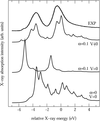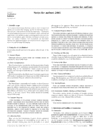issue contents
January 2005 issue

Cover illustration: The most important steps of the metallogenomics pipeline (see Ascone, Fourme, Hasnain and Hodgson, pages 1-3). This is a composite image including figures from this issue (Corbett et al., pages 28-34 and Scott et al., pages 19-22).
facility information
bioXAS and metallogenomics
Free 

An overview of the second special issue of the journal on biological applications of X-ray absorption spectroscopy is presented.
Open  access
access
 access
accessAttempts to produce high-quality protein from the MTB genome using the established pET expression system in E. coli are shown. The difficulties encountered at each stage are assessed and the need for alternative purification methodologies are suggested.
Some relevant issues for high-throughput production of recombinant proteins in Escherichia coli are discussed, with consideration for possible bound cofactors such as metals.
Open  access
access
 access
accessHeterologous overproduction of the copper proteins nitrite reductase and azurin I from Alcaligenes xylosoxidans in Escherichia coli is described. Optimisation of conditions delivered recombinant proteins that were biochemically and spectroscopically indistinguishable from the native proteins.
Technological developments that will be required to perform high-throughput X-ray absorption spectroscopy on components of an organism's proteome are described. These will allow characterization of the organism's metalloproteome, relating metal-site structure and assembly to environmental stress or developmental state.
Integrated instrumentation for polarized single-crystal X-ray absorption spectroscopy and crystallography has been developed and implemented on SSRL beamline 9-3, with initial data for a macromolecular application presented.
The local geometric and electronic structure about the Mo atom in the iron–molybdenum cofactor of nitrogenase in isolated MoFe protein and in the ADP·AlF4−-stabilized MoFe protein–Fe protein complex, as determined by Mo X-ray absorption spectroscopy (XAS), are compared. Additionally, initial polarized Mo K-edge XAS results from a MoFe protein crystal obtained using the new SSRL single-crystal XAS instrumentation are presented.
Time-resolved BioXAS measurements with sub-millisecond resolution are employed to monitor transitions in the catalytic cycle of photosynthetic water oxidation. A novel approach termed `sampling-XAS' is presented and its feasibility to resolve rapid structure and oxidation state changes is demonstrated.
Different statistical criteria and procedures for the quality control of fluorescence XAS spectra are compared and a quality control system for such data is developed.
New methods for EXAFS data analysis are described.
A variety of applications can be covered with standard photodiodes. Commissioning tests of a 35-element array of Si drift-diodes were completed; numerical deconvolution was found to yield well resolved fluorescence lines. Higher energy resolution typically required for RIXS studies was achieved using a high-vacuum-compatible crystal analyzer suitable for polarization analyses.
The Bayes–Turchin approach has been applied to XAS analysis.
A general procedure which computes X-ray absorption near-edge structure spectra starting from the individual configurations obtained from molecular dynamics simulations has been developed and applied to the study of a Ni2+ aqueous solution.
A multichannel extension to multiple-scattering theory for X-ray absorption spectroscopy (XAS) calculations is presented and applied to the L2,3-edge XAS of calcium, an important element for biological applications of XAS.
X-ray absorption spectra of a number of organic iodine and bromine compounds of biological relevance have been measured. The position of the iodine K edge is found to be sensitive to formal valence (among other factors), and EXAFS spectra of organic iodides and bromides can be used to discriminate between aliphatic and aromatic compounds.
The synergism of NMR and XAS spectroscopies for completing and speeding up the structure determination of metalloproteins is described. The usefulness of the approach in structural genomic projects is highlighted.
XANES quantitative structural determination of the sandwich bis(naphthalocyaninato) cerium complex
The molecular structure of the sandwich double-decker bis(naphthalocyaninato) cerium complex was determined for the first time in a quantitative way using a new method of analysis of the Ce L3-edge XANES in the framework of the full multiple scattering theory.
Multiple-scattering calculations for the XAS spectra of met-forms of hemocyanins, performed to refine the structure of their copper 3 active site, are presented.
X-ray absorption spectroscopy has been employed to determine the local structure around the zinc ion of peptide deformylase from Leptospira interrogans in dry powder. XANES calculations were performed and the local geometry of the active center was reconstructed successfully.
current events
Free 

notes for author
Free 



 journal menu
journal menu













































